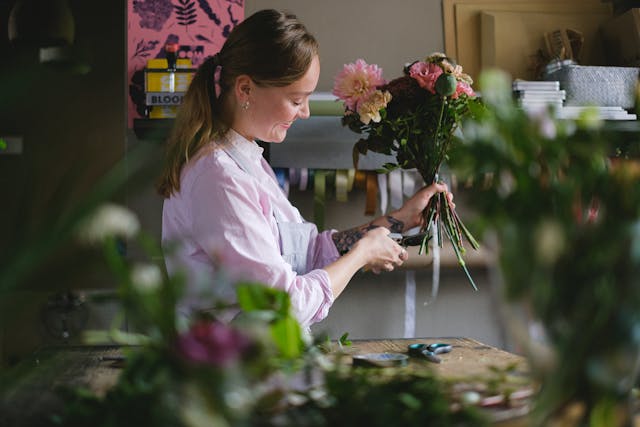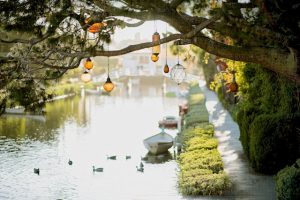One of the main reasons many of us have a garden at all is so that we may cut flowers for the mantlepiece or to give to a friend for dinner. One of the best things about having a garden is that you may have a modest bouquet of sweet peas, an extravagant bunch of dahlias, or simply a few sprigs of greenery for the Sunday lunch table. It may seem unrealistic to have a cutting garden devoted to filling vases, but if you don’t have access to a walled garden for that purpose, don’t worry. A flower that would take center stage in the border suddenly steals the show when it’s in a vase. A window sill arranged with a constellation of bud vases, each holding a single stem, is the ideal approach to get to know the personalities in your garden. A simple forget-me-not may become a masterpiece when transformed into a vase.
But if you want big bunches, you may wish to plant a few extras to have ready for snipping on a Friday night, either sprinkled across borders or even in a special bed. When cultivating flowers for your house, keep in mind these important tips.

Start modest and make thoughtful choices.
A cut flower seed brochure is the most seductive plant catalogue there is, with its rainbow of deliciously appealing flowers that might easily mislead you. Georgie Newbery, a flower farmer and florist from Common Farm Flowers in Somerset, suggests creating the combinations you like prior to planting. What flowers brighten up your Monday morning? Which are heavenly-smelling and rest beside your bed? Do they all function nicely in a vase together?
When working on a limited plot, Florist and Grower Milli Proust advises starting small and making thoughtful choices. She adds, “I know our eyes are often bigger than our time, but they’re often bigger than our vases too.” A tiny area may provide surprisingly large yields, particularly if generous plants like the real “cut and come again” varieties like cosmos, zinnias, dahlias, and sweet peas are grown. They will provide more blooms the more you trim them, and trimming them will stimulate extended blooming times.
The next challenge is to jog your memory of each one’s identity and planting location. Outside In, a book on flowers for the home written by Sean Pritchard, was just released. He suggests “creating a paper diagram as a record of the varieties that you’ve planted and their position in the garden.” Nothing is more annoying than misplacing a label or forgetting the name of an eye-catching flower.
It’s easy to get carried away with the suspense, but filler is just as crucial, so don’t forget about it. Blooms last longer and provide a more natural posey whether paired with gorgeous greenery or less spectacular but abundant flowers. Here, consider perennials: plants that have a long life in the yard and serve as extras for arrangements in vases. Plus, as Camila Romain from Wolves Lane Flower Company reminds out, perennials are considerably better at tolerating difficult conditions than annuals.
In my garden, I have Alchemilla mollis, which I let self-seed everywhere because I love the lime green clouds that it produces in bunches throughout the summer. Not only does Pritchard like Nasturtiums for their blooms, but he also likes the foliage of these plants, especially the “Jewel of Africa” variety, which he says “has mottled leaves and is a must for me every year.”
Make a story plan.
Whether you’re adding to existing borders or creating a new cut flower garden, Camila Romain says that planting with diversity in mind and interplanting a variety of species rather than a monocrop will make your plants more pest-resistant and durable. It will also seem better.
Planning for succession is essential for successful gardening, especially when cutting. Georgie Newbery notes that, “varieties which flower in May and June won’t still be flowering in September – so be prepared to sow/plant in succession for long season success.” This is because, unless the variety is cut and come again, there will be a gap after it has filled a jug for the kitchen table. In order to have something to fill in the void after your vases are full, Sean Pritchard advises planning this out at the beginning of the season.

Remember to condition
After putting in a lot of effort to seed and develop, Pritchard advises cutting your blooms at “the extremes of the day,” which are early morning or nightfall. Before placing them on display, they should be submerged immediately in lukewarm water and, if at all possible, placed in a cool, dark place to rest for a few hours or overnight.
Ultimately, everyone acknowledges that having fun is the most important thing. Gathering flowers from the garden is about as wonderful as it gets; the key is to try different things rather than focus on perfection. Every error serves as a valuable gardening lesson and a chance for something else to fill the vase.
Favorite flowers to cut each year
Although I like the deeply crimson “Beaujolais” and the wonderfully fragrant “Charlie’s Angel,” a dolly combination purchased at a plant sale is always a good choice. A traditional cut and come again, they need constant watering and plucking in order to continue yielding.
Cosmos: another outstanding cut that reappears. The original pure white variety known as “Purity” is available on Milli Proust’s website Alma Proust, along with several stunning, uncommon variations like “Apricotta.” It is important to prickle them early in order to get plentiful stems for examination. excellent for sealing up border gaps.
Nasturtium: although though it’s an annual, you only need to plant it once since it self-seeds and grows back abundantly. They provide as both ground cover and visual interest in the vegetable area where I have them. “Jewel of Africa” is Sean Pritchard’s favorite, while “Ladybird Rose” with her red smudges is mine.
Annuals
Knautia Macedonica is a rich burgundy scabious that is so abundant that I don’t mind pruning it. It’s a fantastic hue and form to combine with other flowers, such as strong limes or pinks.
Alchemilla Mollis is a fantastic low-growing plant for pavement cracks and border edges. The lime green floral sprays enliven pinks and remove the sugary edge from peachy tones.
I have never met a Dahlia that I didn’t like, but the spikey star-shaped Honka varieties make a wonderful contrast to the heavy-headed dinner plates, and Labyrinth is a great pink with a hint of apricot.




